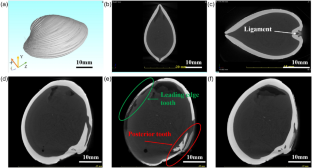Multilevel Micro Structures of the Clam Make the Sealing Even Tighter
Abstract
Excellent fluid sealing performance is crucial to ensuring the safety of important equipment, especially in aerospace field, such as space capsule and fuel chamber. The frequently opening and closing of the sealing devices is particularly important. Driven by this background, clams (Mactra chinensis) which can open and close their double shells with superior sealing performance, are studied in this work. Here, we show that the clam’s sealing ability is the result of its unique multilevel intermeshing microstructures, including hinge teeth and micro-blocks. These microstructures, which resemble gear teeth, engage with each other when the shell closes, forming a tight structure that prevents the infiltration of water from the outside. Furthermore, the presence of micron blocks prevents the penetration of finer liquids. The simulation results of the bionic end seal components show that the multilevel microstructure has a superior sealing effect. This research is expected to be applied to undersea vehicles that require frequent door opening and closing.


 求助内容:
求助内容: 应助结果提醒方式:
应助结果提醒方式:


